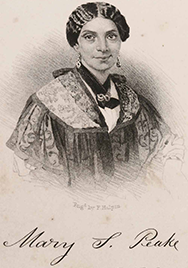Our Namesakes
The BPF is named after two historic and legendary women who contributed immensely to the Hampton community, Mrs. Janie Porter Barrett and Mrs. Mary Smith Kelsey Peake.
Janie Porter Barrett
 Mrs. Janie Porter Barrett was born on August 9, 1865 in Athens, Georgia. She matriculated to Hampton Institute, graduating in 1884. She married Harris Barrett, and, in 1890, she founded the Locust Street Settlement, the first settlement house for Black people. The Barretts were very active in the community and were members of the historic First Baptist Church in Hampton. Barrett would personally petition the court system to turn over delinquent and abandoned girls into her custody. Also, as a social reformer and club woman, she helped create the Virginia State Federation of Colored Women's Clubs, which was a major state organization with city chapters. Through the Federation, they raised money for a residential industrial school for young African American girls. In 1914, a 147 acre farm at Peaks Turnout in Hanover County was purchased, and in 1915, the Virginia Industrial School for Colored Girls opened with 28 students. This school stressed domestic skills, education, self-reliance and discipline. Barrett became the school's first superintendent, and she closely monitored the girls who performed sufficiently well the goals of the School. She shouldered the responsibility to carefully select foster homes, employment, and follow-up services required. In 1920 the state of Virginia assumed financial responsibility for the school. Supervision was shared by the state and the women's club federation until 1942, when it became solely a function of the Virginia Department of Welfare and Institutions. Barrett retired as superintendent in 1940, and her legacy would be venerated as in 1950, the school was renamed The Janie Porter Barrett School for Girls.
Mrs. Janie Porter Barrett was born on August 9, 1865 in Athens, Georgia. She matriculated to Hampton Institute, graduating in 1884. She married Harris Barrett, and, in 1890, she founded the Locust Street Settlement, the first settlement house for Black people. The Barretts were very active in the community and were members of the historic First Baptist Church in Hampton. Barrett would personally petition the court system to turn over delinquent and abandoned girls into her custody. Also, as a social reformer and club woman, she helped create the Virginia State Federation of Colored Women's Clubs, which was a major state organization with city chapters. Through the Federation, they raised money for a residential industrial school for young African American girls. In 1914, a 147 acre farm at Peaks Turnout in Hanover County was purchased, and in 1915, the Virginia Industrial School for Colored Girls opened with 28 students. This school stressed domestic skills, education, self-reliance and discipline. Barrett became the school's first superintendent, and she closely monitored the girls who performed sufficiently well the goals of the School. She shouldered the responsibility to carefully select foster homes, employment, and follow-up services required. In 1920 the state of Virginia assumed financial responsibility for the school. Supervision was shared by the state and the women's club federation until 1942, when it became solely a function of the Virginia Department of Welfare and Institutions. Barrett retired as superintendent in 1940, and her legacy would be venerated as in 1950, the school was renamed The Janie Porter Barrett School for Girls.
Barrett died on August 27, 1948, at the age of 83, and is buried next to her husband, at the historic Elmerton Cemetery in Hampton.
Mary Smith Kelsey Peake

Mrs. Mary Smith Kelsey Peake was born 1823 in Norfolk, Virginia. Born free, she was the daughter of a free Black woman and an Englishman. When she was six, she attended a school for Black children in Alexandria, Virginia. She returned to Norfolk and was affiliated with the historic First Baptist Church, Bute Street. After her family moved to Hampton in 1847, she was a dressmaker and teacher of Blacks in her home. She helped start a benevolent organization called the Daughters of Zion, which provided aid to the poor and infirmed. In 1851, she married Thomas Peake, was a Union dispatcher. In 1861, thousands of Black people escaping enslavement, found refuge at Fort Monroe in Hampton. Working with the American Missionary Association, she defied laws which prohibited Blacks from receiving an education. She started a school on the present grounds of Hampton University, under what is now called Emancipation Oak. Peake taught dozens of students, several who would become leaders in the Hampton community.
She died of tuberculosis on February 22, 1862, at the age of 39. Mary Smith Peake is buried next to her husband, at the historic Elmerton Cemetery in Hampton.
